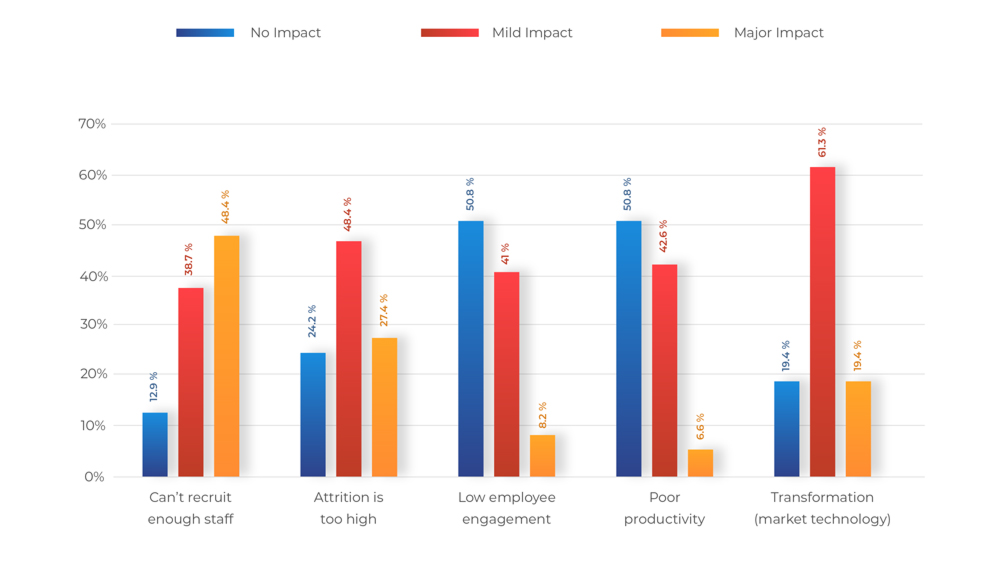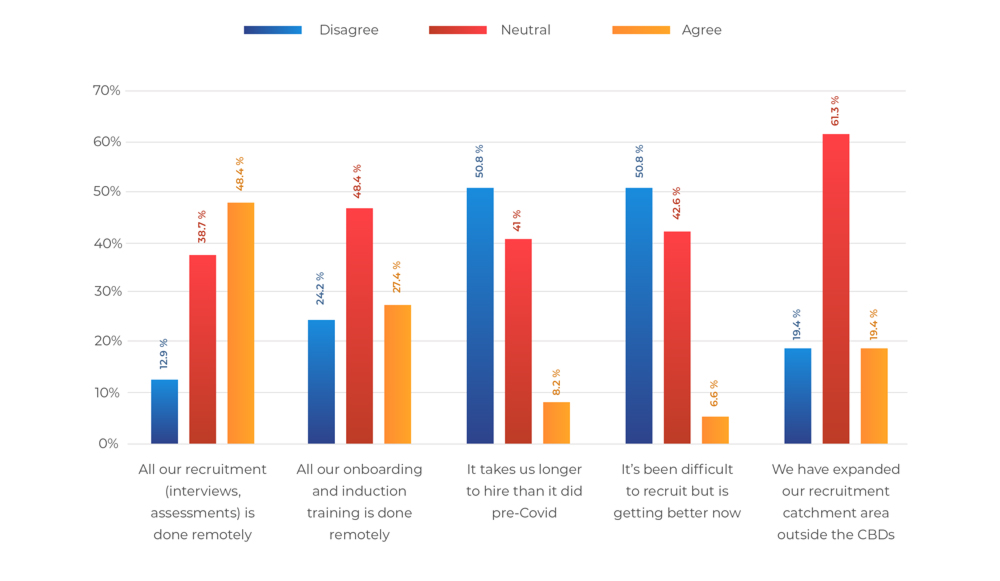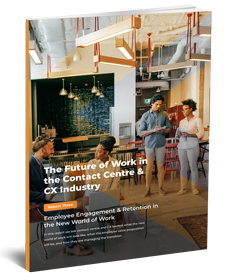What challenges are contact centre and CX leaders facing to attract and retain employees in this job market?
The transition to a new world of work is never going to be smooth. Employers are stuck between going back to doing business like we did pre-pandemic, and grasping the opportunities offered by the transformations that have happened since.
This is only natural. Nobody wants to be the first to jump. And we are still unsure how, exactly, the cards will fall. What do employees really want? What will your competitors do? What do customers want from you?
It’s not just about remote working and the tight job market – the economic winds are blowing this way and that, the cost of living crisis looks like it will be here to say for some time, and then there are the usual business pressures to deal with including technology transformation and new market entrants.
We are definitely struggling more with attrition now than we were pre-Covid. To fix that we have focussed on employee engagement. Our employee satisfaction score sits at 82%, so staff are happy while they’re at work, but not happy enough to stay if they’re offered another role.
Head of Customer Experience, Major retailer
To find out more we interviewed a dozen contact centre and CX leaders in Australia, and did a survey with over 60 leading organisations. The findings shed some light on the challenges businesses are dealing with, and also give some tantalising hints of how things might eventually play out.
Q1: Would you say the following have increased, decreased, or stayed about the same, compared to pre-Covid?
We first wanted to know what has changed for employers since the start of the pandemic. As you can see from the graph below, most companies have been affected in some way or other.

The stand-out change is that most companies’ vacancy rates have increased since early 2020. Most have also experienced an increase in their attrition rate, although the attrition rate in the first 3 months has risen a little less. Pay rates for frontline workers have also gone up for most, although a surprising number haven’t changed. Average tenure has dramatically decreased for the majority, which is not surprising given the rise in attrition rates.
Attrition has reduced somewhat since the lockdowns. That’s probably because there’s more action in the office. When people start now they get a better experience so 3 month attrition has dropped. They feel connected to the brand and people when they spend some time in office.
Head of Call Centre Operations, Health Insurance company
Q2: What are the biggest issues impacting your contact centre right now?
We asked leaders what are the biggest issues facing their contact centre right now. By far the biggest problem was the inability to recruit enough staff. 48% of responders said this was having a major impact and 39% said it was having a mild impact. Only 13% said they weren’t feeling any impact at all.

Although the impact is milder, almost as many responders say they are experiencing higher than usual attrition. Transformation challenges (markets, technology) are having the next biggest impact on contact centres. Finally, low employee engagement, and poor productivity are issues for over 50% of responders, but the impact of both these challenges is mostly mild.
Free Report
Download our latest free report "Employee Engagement and Retention in the New World of Work" for a deeper dive into these topics.
Download Now
Q3: Thinking about your recruitment and onboarding, how much do you agree with the following statements?
As its the most important issue employers are facing, we asked specifically about their recruitment processes. We wanted to know what they had been forced to change since the start of the pandemic to compete in the job market.

Almost 60% of responders said it takes them longer to recruit now than it did before. To make it easier to recruit, more than half have expanded their catchment areas outside of the CBD. Remote and hybrid working enable this as a solution.
Surprisingly few companies appear to have switched to an all-remote hiring process, with only 31% saying that all their interviews and assessments are done remotely. The vast majority also appear to be doing their onboarding and induction training face-to-face, with only 17% saying they do it all remotely.
Finally, there is little agreement on whether the recruitment situation is getting better yet, with roughly a third saying it is, a third saying it isn’t, and another third perhaps wisely sitting on the fence for now.
Q4: In your experience what are the most important factors that influence attrition?
Finally, we asked about attrition. We wanted to know what factors most influence attrition these days.

Unsurprisingly, the main factor that influences attrition was the ability to work from home, followed closely by salary and benefits. This is a reversal of our recent candidate survey which had salary first by quite some distance.
Close behind was the ability to have a flexible work schedule. This is important for truly enabling employees to fit work around their other life commitments. In our recent employee flexibility of hours worked actually came in above location flexibility, so it’s interesting that employers have them the other way around.
The second most important factor in our employee survey was job promotion prospects. For employers this was the joint-fourth most important factor, alongside a flexible work schedule – although employers also ranked having a friendly and relaxed work environment above both of those. Company culture was another factor that scored highly.
We did an analysis on retention. The main issue was a sense of belonging. If you work remotely and you don’t know anyone, you’re not letting anyone down. It’s a lonely job working on your own. People stay longer when they feel part of something bigger, part of a team that shares and learns from each other.
Head of Member Services, Retirement fund
Towards a new Employee Value Proposition
This survey sheds light on both the challenges contact centres are facing in the wake of the pandemic-induced transformations the job market has undergone. The answers given by our industry leaders also point towards some trends that signpost a way forward.
These include moving to a more remote and streamlined recruitment process that widens the available talent pool, and also giving employees more of what they say they want – which includes higher pay (of course), more flexible working, better working conditions, and the opportunity to develop their skills.
In short, employees are demanding a better employee experience. A new employee value proposition.
The employee value proposition has usually been expressed in terms of the role and responsibilities the employer is hiring for, as well as the company’s culture, working environment, goals and social responsibilities, and commitment to providing employees with opportunities.
This is a good start, but in the new world of work, if you want to be an employer of choice, it is not enough.
The new employee value proposition represents an opportunity to fundamentally redefine what work is, and the relationship between employee, employer and work. It is built on two fundamental pillars, which we will look at now.
We ensure we have career pathways mapped out properly so people understand what opportunities are available. All team leaders have action and development plans so they don’t feel they are stuck at entry level. Sometimes candidates don’t know what they want, but it comes as they get into the role and learn about the industry and company. Some might be fresh out of University and know they want to go into L&D or underwriting, or whatever.
Head of Learning & Quality, Global insurance company
Free Report
Download our latest free report "Employee Engagement and Retention in the New World of Work" for a deeper dive into these topics.
Download Now


